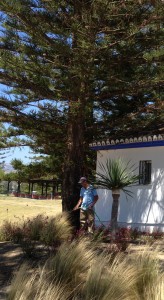MIJAS GOLF APUESTA POR LA XEROJARDINERÍA – MIJAS GOLF COMMITTED TO XERISCAPE
ESPAÑOL
Aunque la definición que ocupa nuestro título de hoy genere cierta incertidumbre, nos estamos refiriendo simplemente a lo que sería un jardín “de bajo consumo”¿A que ahora se entiende mejor?
Y un jardín así no es más que uno cuyas plantas son en su mayoría autóctonas o pertenecientes a climas similares al nuestro; que son las que –lógicamente- mejor se adaptan a la luz, la humedad y las condiciones de nuestro suelo.
La palabra xerojardinería empezó a escucharse en Estados Unidos a principios de los 80. El prefijo Xero significa seco. La sequía que azotó el Oeste del país en los 70 hizo urgente la necesidad de idear un nuevo concepto de jardines que fuera más respetuoso con los recursos naturales.
Este tipo de jardinería rechaza totalmente el despilfarro del agua, más aún en climas donde ésta supone un bien escaso.
La Xerojardinería llegó a España en la década de los 90, auspiciada también por una fuerte sequía.
Tras esta introducción, enseguida se nos viene a la mente un lugar lleno de cactus y chumberas invadido por colores ocres. Pero la realidad es que, entre estos jardines sostenibles, se pueden encontrar verdaderas maravillas en cuanto a diseño y variedad, y que suponen – a su vez- nuevos hábitats para las abejas y mariposas nativas.
Ya veis…Un espacio natural que casi se mantiene sólo en el que todo son ventajas. Una inversión ecológica que devuelve a la naturaleza una millonésima parte de lo que ella nos viene regalando durante siglos.
Apostar por esta iniciativa es nuestro pequeño empujoncito para mejorar, aunque sea un poco, el entorno que nos rodea: Está demostrado que un jardín diseñado y mantenido con criterios de uso eficiente del riego consume apenas una cuarta parte del agua que se gasta en un jardín convencional.
De momento, en Mijas Golf, se pueden encontrar zonas de estas características en los alrededores del área de prácticas, junto a la caseta del Starter. Pero, en un futuro próximo, podremos disfrutar también de estos jardines en espacios puntuales repartidos a lo largo de todo el campo.
ENGLISH
You may feel confused by this strange word in the title, but we are simply referring to a “low-power” garden. Clearer now, isn’t it?
And a garden of his kind is one mainly integrated by autochthonous or from a similar climate plants; as these are – obviously – much more adaptable to our landing’s light, humidity and conditions.
The word Xeriscape started to be used in the United States in the early 80s. “Xero” means dry. A drought hit the west of USA during the seventies and showed the urgent need to devise a new concept in garden to be more respectful of natural resources.
This type of gardening totally rejects the wastefulness of water, specially in climates where it is a scarce.
Xeriscape came to Spain in the 90s also fostered by a harsh drought.
After this introduction, it is easy to imagine a strow-colored place full of cactus and prickly pears. But, in fact, many of these sustainable gardens are truly amazing because of their design and variety; and they are, at the same time, new habitats for the native bees and butterflies.
You see…a natural area that requires very little maintenance and full of other advantages. An ecological investment to pay back to nature just a millionth of its immense and selfless gift.
The commitment to this initiative is our little contribution to improve our environment’s health: You can verify that a garden designed and kept with an efficient use of irrigation consumes only a quarter of the water spent in a conventional garden.
For the moment, at Mijas Golf, you will find these features spaces around the practice area, by the starter’s Hut. But, in the nearer future, we will be able to enjoy of these gardens dotted also along the course.




